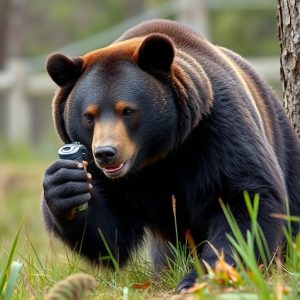Unlocking Safety: Mastering Alaska Bear Spray’s Dispersal for Effective Protection
Bear spray, a non-lethal defense against bears, uses capsaicin to create a 20-30 foot cloud dispersa…….
Bear spray, a non-lethal defense against bears, uses capsaicin to create a 20-30 foot cloud dispersal range, temporarily disabling them. Effective usage involves aiming at eye level and understanding environmental factors like wind and terrain that influence its reach. Proper application, storage (40°F–80°F), and use of the lock mechanism ensure optimal 30-foot bear spray cloud dispersal range for safety in bear country.
In Alaska’s diverse wilderness, understanding bear spray technology and its effectiveness is crucial for outdoor enthusiasts. This article delves into the science behind bear spray, exploring factors that influence its cloud dispersal range. We’ll guide you through best practices for usage and storage, emphasizing the vital role of the safety lock mechanism. By grasping these aspects, adventurers can enhance their safety and ensure optimal performance when facing potential bear encounters.
- Understanding Bear Spray Technology: How It Works
- Factors Affecting Bear Spray Cloud Dispersal Range
- Best Practices for Using and Storing Alaska Bear Spray
- Why the Lock Mechanism is Crucial for Safety and Effectiveness
Understanding Bear Spray Technology: How It Works
Bear spray, also known as bear deterrent or pepper spray, is a crucial tool for personal safety in areas where bears are present. Understanding how it works is essential when considering its effectiveness and proper use. When deployed, bear spray creates a cloud of spray that disperses in all directions, targeting the bear’s eyes, nose, and mouth. This rapid dispersal range, often ranging from 20 to 30 feet (6 to 9 meters), temporarily blinds and irritates the bear, providing the user with valuable time to escape or defend themselves.
The active ingredient in bear spray is usually capsaicin, derived from chili peppers. When inhaled by a bear, it triggers a reaction similar to that of spicy foods on human senses, causing the bear to react aggressively and retreat. The technology ensures a non-lethal solution, allowing people to coexist with bears more safely. Proper usage involves aiming for the face and maintaining a safe distance, which, when combined with knowledge of bear behavior, can significantly enhance survival chances in potentially dangerous encounters.
Factors Affecting Bear Spray Cloud Dispersal Range
The effectiveness of bear spray cloud dispersal range can be influenced by several key factors. One major determinant is the size and composition of the spray cloud itself. Larger clouds, containing finer particles, tend to disperse more slowly and over a broader area due to their increased surface area and reduced air resistance. In contrast, smaller droplets may travel shorter distances before settling, affecting the overall reach of the spray.
Wind conditions play a crucial role in bear spray cloud dispersal as well. Strong winds can carry the spray further, while calm or light breezes might limit its range. The direction of the wind is also significant; an optimal tailwind can extend the reach, whereas headwinds may impede the dispersion process. Additionally, environmental factors like terrain and vegetation density can impact the cloud’s path and longevity. Rough terrain can cause turbulence, altering the spray’s trajectory, while dense foliage might act as a barrier or absorber of the spray particles.
Best Practices for Using and Storing Alaska Bear Spray
When using Alaska bear spray, understanding the best practices for application and storage is crucial for ensuring its effectiveness in potential encounters. The key to successful deployment lies in knowing the ideal distance to maintain from the bear—typically within a 30-foot range—and aiming for eye level. This ensures that the spray forms a cloud that covers both the bear and its path, providing maximum protection. Practice holding the canister firmly while activating it with one hand, allowing for quick response times.
Storage is equally important; keep your bear spray in an easily accessible location, preferably on your person or within immediate reach during outdoor activities. Ensure it remains sealed until use to prevent accidental discharge and maintain optimal performance by storing it in temperatures between 40°F–80°F (4.4°C–26.7°C). Regularly inspect the spray for any signs of damage or deterioration, replacing it if needed, to guarantee its cloud dispersal range remains effective when you need it most.
Why the Lock Mechanism is Crucial for Safety and Effectiveness
The lock mechanism on Alaska bear spray is a crucial component that ensures both safety and effectiveness during encounters with bears. In stressful situations, when split-second decisions matter, this simple feature allows users to activate the spray quickly and reliably, providing a protective cloud dispersal range of up to 30 feet (9 meters).
By securing the spray, the lock mechanism prevents accidental activation, ensuring that the bear spray is only deployed when intended. This is particularly vital in rugged outdoor settings where accidental discharge could have severe consequences, not just for the user but also for nearby wildlife and fellow adventurers.
The effectiveness of bear spray depends significantly on proper usage and a secure storage system, especially in Alaska’s diverse environments. Understanding how bear spray technology works and the factors influencing its cloud dispersal range is key to ensuring safety in bear country. By following best practices for application and storage, using the lock mechanism responsibly, and being mindful of environmental conditions, outdoor enthusiasts can maximize their protection against potential bear encounters. This knowledge empowers individuals to navigate Alaska’s wilderness with confidence and peace of mind.


